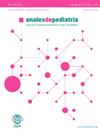Neuromonitorización y seguimiento en pacientes con cardiopatía congénita en España
IF 1.5
4区 医学
Q2 PEDIATRICS
引用次数: 0
Abstract
Introduction
There is evidence of the high incidence of neurological abnormalities in patients with congenital heart disease (CHD). Despite this, perioperative neuromonitoring strategies and long-term followup protocols are not standardized in Spain.
Objective
The aim of our study was to describe current clinical practice in neuromonitoring, neuroimaging and neurodevelopmental followup in patients with CHD in Spanish hospitals that perform paediatric cardiac surgery (PCS).
Material and method
We conducted a survey by adapting a questionnaire originally developed by the European Association Brain and Congenital Heart Disease Consortium to collect data on aspects such as the implementation of perioperative neuromonitoring and the type of neuroimaging techniques and neurological followup performed. The questionnaire was distributed to the 19 Spanish hospitals that perform PCS.
Results
We received responses from 17 centres. Eighty-eight percent performed some type of preoperative neuroimaging and 81% postoperative monitoring. The most widely used technique was transfontanellar sonography. Fifty-six percent of the centres used some form of intraoperative neuromonitoring, most frequently near-infrared spectroscopy. Nineteen percent had an established protocol for the followup of these patients and 13% were in the process of developing it.
Conclusions
There is considerable heterogeneity in neuromonitoring, neuroimaging and neurologic followup practices in the management of patients with CHD in hospitals that perform PCS in Spain. These findings highlight the need to pursue a consensus in order to standardise neuromonitoring and neurologic followup strategies in children with CHD in Spain.

西班牙先天性心脏病患者的神经监测和随访
有证据表明先天性心脏病(CHD)患者神经系统异常的发生率很高。尽管如此,围手术期神经监测策略和长期随访方案在西班牙尚未标准化。目的本研究的目的是描述目前在西班牙医院进行儿科心脏手术(PCS)的冠心病患者的神经监测、神经成像和神经发育随访的临床实践。材料和方法我们采用欧洲脑和先天性心脏病协会最初开发的问卷进行调查,收集围手术期神经监测的实施、神经成像技术的类型和神经学随访等方面的数据。调查问卷已分发给19家实施个人护理的西班牙医院。结果我们收到了来自17个中心的回复。88%的患者进行了某种类型的术前神经成像,81%的患者进行了术后监测。最广泛使用的技术是经囟门超声。56%的中心使用某种形式的术中神经监测,最常见的是近红外光谱。19%的医院为这些患者的随访制定了既定的方案,13%的医院正在制定方案。结论西班牙实施PCS的医院在冠心病患者的神经监测、神经影像学和神经病学随访方面存在相当大的异质性。这些发现强调了需要寻求共识,以便对西班牙冠心病儿童的神经监测和神经随访策略进行标准化。
本文章由计算机程序翻译,如有差异,请以英文原文为准。
求助全文
约1分钟内获得全文
求助全文
来源期刊

Anales de pediatria
医学-小儿科
CiteScore
2.10
自引率
4.80%
发文量
155
审稿时长
44 days
期刊介绍:
La Asociación Española de Pediatría tiene como uno de sus objetivos principales la difusión de información científica rigurosa y actualizada sobre las distintas áreas de la pediatría. Anales de Pediatría es el Órgano de Expresión Científica de la Asociación y constituye el vehículo a través del cual se comunican los asociados. Publica trabajos originales sobre investigación clínica en pediatría procedentes de España y países latinoamericanos, así como artículos de revisión elaborados por los mejores profesionales de cada especialidad, las comunicaciones del congreso anual y los libros de actas de la Asociación, y guías de actuación elaboradas por las diferentes Sociedades/Secciones Especializadas integradas en la Asociación Española de Pediatría.
 求助内容:
求助内容: 应助结果提醒方式:
应助结果提醒方式:


